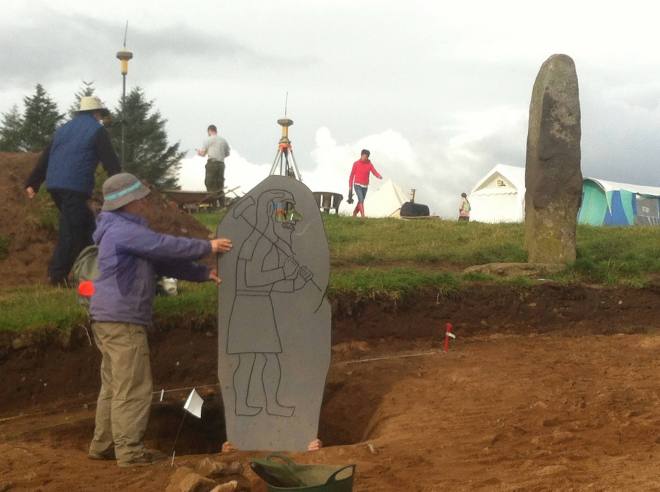For those of you with an interest...
You can see the paper delivered by Dr Gordon Noble and Dr Meggen Gondek at the Scotland in Early Medieval Europe Conference (Feb 2012) on the Society of Antiquaries online Resources webpage (click above and it should bring you there).
Obviously this isn't our most up-to-date paper, but a chance to hear some of the results of the 2011 and 2012 work as well as the context of our work here.
Happy Viewing!
Rhynie, Aberdeenshire

The Craw Stane with Tap o'Noth hillfort in the background (Photo courtesy of Cathy MacIver).
Tuesday 15 September 2015
Wednesday 9 September 2015
The words of Rhynie Man
In case you don't follow it already...
Check out the musings of Rhynie Man (and the pictures!) for help in understanding what life is like for an axe-bearing, mullet-wearing Pictish guy: https://therhynieman.wordpress.com/
Check out the musings of Rhynie Man (and the pictures!) for help in understanding what life is like for an axe-bearing, mullet-wearing Pictish guy: https://therhynieman.wordpress.com/
 |
| Rhynie Man was here? photo courtesy of Rhynie Man |
I always make the same bad joke about Rhynie Man - I describe him as 'life sized - if you believe I'm life-sized' and here's the evidence to prove it!
Meggen
Planks for the Memories 2015!
In the next few days-weeks we will be posting a recap of our site, features and finds - but for now a quick summary and a gratuitous pun...
It was a fantastic year with some vexing features (curse you annexe ditch!) and great discoveries like our possible stone-hole near the entrance to the outer ditch. Our key thoughts as we turn to writing up this year's results:
The palisade architecture does appear to be complex with massive planks or split timbers set at the inner edge of the foundation cut. The regularity of the palisade post-holes seems pretty convincingly to point to these working together with the supports in the palisade trench and a type of box-rampart superstructure is likely. We have some evidence of additional beams and supports linking palisade postholes, as well, particularly near the entrance to the enclosure.
Our ditches seem largely to have been infilled with windblown sand deposits with the occasional dump of more organic or turfy material. We have good potential for dating some of the lower fills from our investigations into both the inner and outer ditches this year.
The annexe ditch, although substantial in APs and in our drone shots, turned out to be a rather shallow affair. We are still working on the idea of it as a foundation trench for a possible turf wall (with all the turf long gone). The annexe was in use before the palisade was built and before the outer ditch was dug. Our working theory is that this was a livestock enclosure, but mulling continues on that one.
Our finds! More evidence for imported materials, high-level metalworking and ornate dress-sense at the site.
So, a very successful year. Many thanks to the great support of both of our universities, Historic Scotland, Aberdeenshire Council archaeologists, our funders, the volunteers, students, Rhynie Woman and the whole village of Rhynie. More updates to come!
 |
| Ghost planks and split timbers in the palisade trench. |
It was a fantastic year with some vexing features (curse you annexe ditch!) and great discoveries like our possible stone-hole near the entrance to the outer ditch. Our key thoughts as we turn to writing up this year's results:
The palisade architecture does appear to be complex with massive planks or split timbers set at the inner edge of the foundation cut. The regularity of the palisade post-holes seems pretty convincingly to point to these working together with the supports in the palisade trench and a type of box-rampart superstructure is likely. We have some evidence of additional beams and supports linking palisade postholes, as well, particularly near the entrance to the enclosure.
Our ditches seem largely to have been infilled with windblown sand deposits with the occasional dump of more organic or turfy material. We have good potential for dating some of the lower fills from our investigations into both the inner and outer ditches this year.
The annexe ditch, although substantial in APs and in our drone shots, turned out to be a rather shallow affair. We are still working on the idea of it as a foundation trench for a possible turf wall (with all the turf long gone). The annexe was in use before the palisade was built and before the outer ditch was dug. Our working theory is that this was a livestock enclosure, but mulling continues on that one.
Our finds! More evidence for imported materials, high-level metalworking and ornate dress-sense at the site.
So, a very successful year. Many thanks to the great support of both of our universities, Historic Scotland, Aberdeenshire Council archaeologists, our funders, the volunteers, students, Rhynie Woman and the whole village of Rhynie. More updates to come!
Subscribe to:
Posts (Atom)